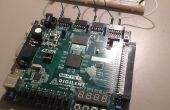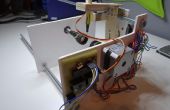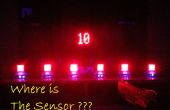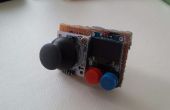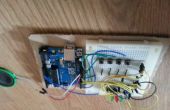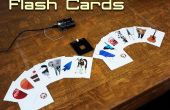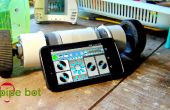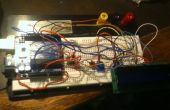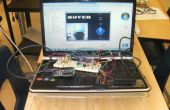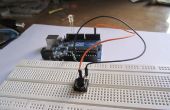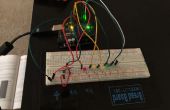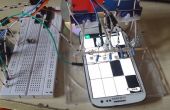Paso 3: código
/*
* Botón Arduino juego
*
* Desarrollado por Mohammed Adil
* B.Tech 3er sem
* Estudiante en la Universidad profesional encantadora
* */
int led [5] = {4,5,6,7,8}; LEDs para 1 jugador
led_1 int [5] = {9,10,11,12,13}; //LEDs para jugador 2
int i = 0;
int j = 0;
button_1 int = 0; //Button entrada para jugador 1
int button_2 = 0; //Button entrada para jugador 2
void setup() {}
Modo de entrada de Pin
para (int thispin = 4; thispin < 14; thispin ++)
{
pinMode(thispin,OUTPUT);
}
Modo de salida de Pin
pinMode(2,INPUT);
pinMode(3,INPUT);
}
void loop()
{
button_1=digitalRead(2); Leer el valor inicial del jugador 1
button_2=digitalRead(3); Leer el valor inicial del jugador 2
{if(button_1==High)}
hacer
{
digitalWrite(led[i],HIGH);
} while(digitalRead(2)==HIGH);
if(i<4)
{
i ++;
}
if(i==4) más
{
para (int thispin = 4; thispin < 9; thispin ++)
{
digitalWrite(thispin,LOW);
}
Delay(200);
para (int thispin = 4; thispin < 9; thispin ++)
{
digitalWrite(thispin,HIGH);
}
Delay(200);
para (int thispin = 4; thispin < 9; thispin ++)
{
digitalWrite(thispin,LOW);
}
Delay(200);
para (int thispin = 4; thispin < 9; thispin ++)
{
digitalWrite(thispin,HIGH);
}
Delay(200);
para (int thispin = 4; thispin < 14; thispin ++)
{
digitalWrite(thispin,LOW);
}
j = 0;
i = 0;
}
otra cosa
{
i = 0;
}
}
if(button_2==High)
{
hacer
{
digitalWrite(led_1[j],HIGH);
} while(digitalRead(3)==HIGH);
if(j<4)
{
j ++;
}
if(j==4) más
{
para (int thispin = 9; thispin < 14; thispin ++)
{
digitalWrite(thispin,LOW);
}
Delay(200);
para (int thispin = 9; thispin < 14; thispin ++)
{
digitalWrite(thispin,HIGH);
}
Delay(200);
para (int thispin = 9; thispin < 14; thispin ++)
{
digitalWrite(thispin,LOW);
}
Delay(200);
para (int thispin = 9; thispin < 14; thispin ++)
{
digitalWrite(thispin,HIGH);
}
Delay(200);
para (int thispin = 4; thispin < 14; thispin ++)
{
digitalWrite(thispin,LOW);
}
i = 0;
j = 0;
}
otra cosa
{
j = 0;
}
}
}
